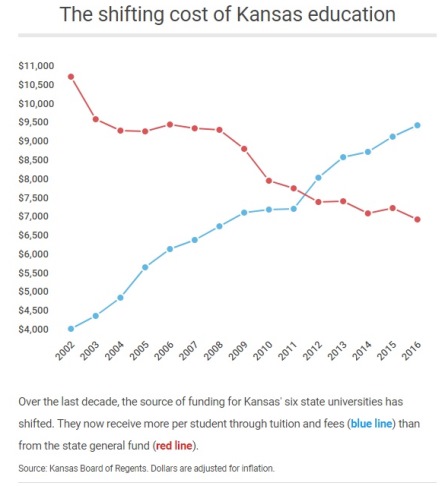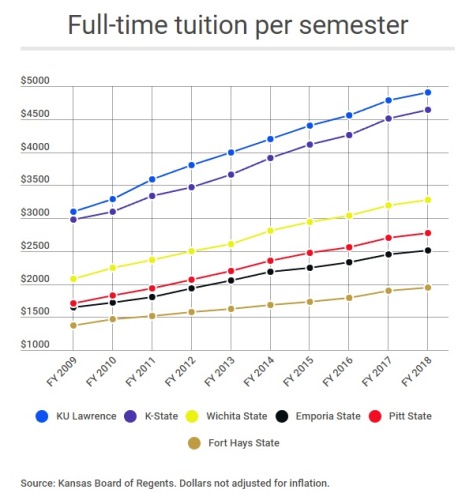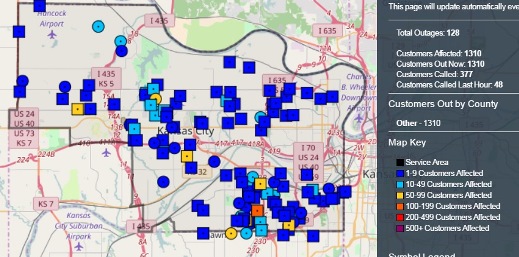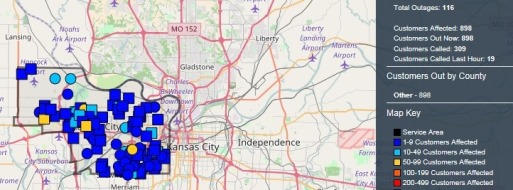
by Celia Llopis-Jepsen, Kansas News Service
The cost of higher education in Kansas continued to swell last week, carrying on a long-running trend in which universities rely increasingly on tuition and fees to operate.
This fall, a full-time semester at the University of Kansas will cost nearly $2,000 more than a decade earlier. The increase at Kansas State University has been similar.
Also over the last decade, the state’s spending per student at Kansas Board of Regents universities has slid.
Board members expressed reluctance to approve the latest round of tuition hikes during their meetings last week — and a few voted against them.
“It’s really heartbreaking to do this,” Regents Chairwoman Zoe Newton said of the increases ranging between 2.5 percent and 2.9 percent for the six state universities in the regents system. “I would hope it’s not going to just keep going up and up.”
In hours of discussion and deliberation last week, the regents worried about hindering would-be first-generation college students — a group that public universities have been courting amid ambitious goals to boost the rate of Kansans who obtain higher education degrees by 2020.
The regents wondered whether the burgeoning cost of postsecondary education makes sense in light of the salaries that many graduates can expect to earn in professions like teaching and nursing.
A Kansas Department of Labor survey put the average starting salary for an elementary teacher in Kansas around $35,500 in 2015. For a registered nurse it was about $43,300.
Regent Ann Brandau-Murguia, a resident of the Argentine neighborhood in Kansas City, Kan., was among those on the board who called for lower increases than were ultimately approved.
“I see every day the challenges that low-income families experience,” she said, “just with daily quality of life issues, let alone trying to overcome the hurdles and the stumbling blocks to get into higher education.”
But Kansans who head to college today do so in an environment where regents universities depend more on tuition and fees than state appropriations to pay the bills.
That has been the case since 2012, and the gap has steadily widened. In 2016, tuition and fees provided more than $9,600 per student and the state general fund provided about $7,100. A decade ago, tuition and fees brought in $6,300 per student and the state put in about $9,600.
The average 2015 college graduate in Kansas left school with just over $28,000 in debt, according to an analysis of available data by the Institute for College Access and Success Project on Student Debt. That’s higher than averages in all four neighboring states, which ranged from $24,900 in Oklahoma to $27,500 in Missouri.
The tuition hikes for next fall are, percentagewise, the lowest in a decade. Year-to-year increases have often topped 5 percent.
“We don’t want to keep students away because of the tuition,” KU Chancellor Bernadette Gray-Little said. “So every time we have a tuition increase, it’s kind of a balancing act between what we need and what we can afford.”
In making their case to the regents this week, the university presidents said the tuition increases would cover only part of the needs at their institutions, where utility bills, state-mandated pension contributions and other expenses are on the rise.

“We’re going to have to cut all the units — academic and other units, administrative units on campus — to make up that $7 million” not covered by raising tuition, K-State President Richard Myers said. “And that’s going to be traumatic.”
A slide in enrollment has compounded the situation at K-State, but all six state universities have experienced declining state aid per pupil.
“We’ve seen that trend nationally,” Board of Regents CEO Blake Flanders said, “and we’re hoping that Kansas will go against that trend and not have a disinvestment in higher education.”
He added: “It’s concerning to us because we know that higher education attainment benefits Kansas and it benefits individual Kansans.”
“We’re hoping that Kansas will go against that trend and not have a disinvestment in higher education.”
In 2010 the regents launched a 10-year agenda to reach a 60 percent postsecondary degree and certification rate among Kansas adults by 2020, citing economic research on changing job markets and workforce demands. Though more Kansans are continuing their educations after high school, the state is not on target to reach the 2020 goal.
Meanwhile, university budgets were trimmed in recent years amid a tailspin in state revenue that at times prompted Gov. Sam Brownback and the Legislature to change course midyear and pull back on spending.
Last year the university system lost 4 percent of its budget. This month — after scuttling Brownback’s signature 2012 tax policies to raise an estimated $1.2 billion in extra revenue — the Legislature agreed to restore in the next two fiscal years about a quarter of what the universities had lost.
Brandau-Murguia took that as a sign Kansas should start tackling the rising cost of higher education.
“We’ve had some tough economic times in the state of Kansas over the last four years,” she said. “But now, given the Legislature’s recent action, I think it’s important to begin to focus on tuition and making sure it’s manageable for families.”
Celia Llopis-Jepsen is a reporter for the Kansas News Service, a collaboration of KCUR, Kansas Public Radio and KMUW covering health, education and politics. You can reach her on Twitter @Celia_LJ. Kansas News Service stories and photos may be republished at no cost with proper attribution and a link back to kcur.org.
See more at http://kcur.org/post/tuition-rates-increase-kansas-regents-universities-state-spending-student-slides.


